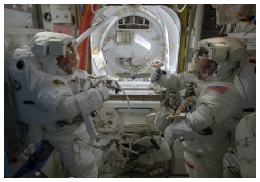
WESTBOURNE VILLAGE ASTRONAUT
Ground Control To Major Tim
Home | Space Station | Career Preparation | Agencies | Itinery | ESA | Space Walk | Satellite Orbits | For Kids | Feed Back | Village Website
TIM PREPARES FOR SPACE WALK
 ESA astronaut Tim Peake and NASA astronaut Tim Kopra will exit the International Space Station next week to repair a power unit on the outside.
ESA astronaut Tim Peake and NASA astronaut Tim Kopra will exit the International Space Station next week to repair a power unit on the outside.
The two Tims arrived at the Space Station on 15 December but this will be their second involvement in a space walk: Tim Peake assisted Tim Kopra and Station commander Scott Kelly when they moved an equipment carrier on 21 December.
The new space walk will last around six hours on 15 January, with Tim Kopra and Tim Peake working closely together to replace a faulty unit. The ESA astronaut explains: “Our primary task will be to replace a failed Solar Shunt Unit, which transfers electrical power generated by the solar panels.” The unit is relatively easy to replace because it is a simple box that can be removed by undoing one bolt. Once done, the space walkers will lay cables in advance of new docking ports and reinstall a valve that was removed for the relocation of the Leonardo module last year.
Inside the Station, Scott Kelly will help the space walkers into and out of their suits – a major operation in itself. Before the astronauts leave they will breathe pure oxygen for two hours to purge their bodies of nitrogen. The spacesuit pressure is lower than in the Space Station and the drop could give them the ‘bends’, much like scuba divers rising too quickly to the sea surface. Donning their spacesuits and safety equipment will take hours before they enter the airlock to reduce the pressure until it is safe to open the exterior hatch.
Tim Peake comments, “I am thrilled at this opportunity for a space walk. Right now we are focusing on preparing the tools, equipment and procedures. “Maintaining the International Space Station from the outside requires intense operations -
The space walk is scheduled to begin at approximately 12:55 GMT and planned to last for about 6 hours. The failed voltage regulator, known as a Sequential Shunt Unit (SSU), is located on the starboard end of the main ISS truss (the large structure that holds the solar panels). This task should take about 3 hours, after which Peake and Kopra will undertake a number of preparatory tasks that are needed for upcoming configuration changes.
This will be a challenging space walk, owing to the nature of the SSU and the power it carries. The SSUs are part of a chain of electronics that regulates and distributes the electricity generated by the solar panels. The job of the SSU is to regulate the voltage coming from the Solar Array by changing which parts are connected to the system. The replacement of the SSU must occur during eclipse, when the solar panels aren’t generating any power. If the swap cannot be completed before the station moves back into sunlight, the crew will have to stay away from any exposed electrical connectors and wait for the next night pass.
This is very similar to a space walk that was done back in 2014 by Reid Wiseman and Barry Wilmore when another SSU failed. There are 8 of these SSUs, one for each of the 8 solar arrays.
After the SSU replacement is complete, the crew will return the failed unit to the airlock and pick up new equipment for the second half of the space walk, where they will work on different tasks. Tim Peake will route some cables in preparation for the arrival of the 2 new Interface Docking Adapters (IDAs). These will be the new docking ports for the commercial crew vehicles that the USA is developing.
Source: https://principia.org.uk